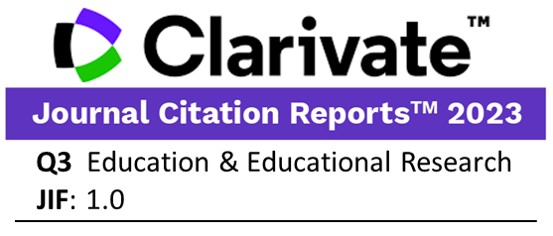Gaze, Conversational Structures, and Mediation in Chilean Primary Education
DOI:
https://doi.org/10.24320/redie.2025.27.e10.6086Keywords:
classroom, eye movements, interaction analysis, primary education, mediationSupporting Agencies:
Proyectos FONDECYT 1200106 y 1150273, Gobierno de Chile.Abstract
The aim of this study is to analyze the relationship between conversational structures, mediation criteria, and eye movements of teachers working in different socioeducational contexts in Chilean primary classrooms. A mixed-methods approach was used with a quantitative focus, which included the use of multivariate analysis and within-subject tests. The study included 40 teachers from 24 elementary schools: 11 schools in the urban area of the Santiago Metropolitan Region and 13 rural schools in Araucanía. Actual lessons were filmed using eye-tracking lenses; the teachers’ gaze behavior was analyzed in classroom exchanges with and without the presence of criteria of Reuven Feuerstein’s mediated learning experience theory. The results indicate that gaze towards students is greater in exchanges with mediated learning experience criteria, compared to those without, and gaze duration on students or their materials is greater in rural classrooms.
Downloads
References
Assael, C. (2020). Tensiones entre la igualdad y la diferencia: la construcción del otro desde los discursos de los docentes. Revista Q, 11(22), 10-22. http://hdl.handle.net/20.500.11912/8102
Burch, M., Haymoz, R. y Lindau, S. (2022). The benefits and drawbacks of eye tracking for improving educational systems. 2022 Symposium on Eye Tracking Research and Applications.
Emanuelsson, J. y Sahlström, F. (2008). The price of participation: Teacher control versus student participation in classroom interaction. Scandinavian Journal of Educational Research, 52(2), 205-223. https://doi.org/10.1080/00313830801915853
Ferrada, D. (2017). Formación docente para la diversidad. Propuestas desde la región del Biobío, Chile. Revista Mexicana de Investigación Educativa, 22(74), 783-811.
Ferreira, J. M., Karila, K., Muniz, L., Amaral, P. F. y Kupiainen, R. (2018). Children’s perspectives on their learning in school spaces: What can we learn from children in Brazil and Finland? International Journal of Early Childhood, 50, 259-277. https://doi.org/10.1007/s13158-018-0228-6
Feuerstein, R., Falik, L. H. y Feuerstein, R. S. (2015). Changing minds and brains - the legacy of Reuven Feuerstein. Higher Thinking and Cognition Through Mediated Learning. Teachers College Press.
Figueroa, I. (2016). Rol mediador de aprendizajes en educación parvularia: procesos de apropiación en el contexto de una propuesta formativa en experiencia de aprendizaje mediado. Summa Psicológica UST, 13(1), 33-44.
Gardner, R. (2014). Conversation analysis in the classroom. En J. Sidnell Y T. Stivers (Eds.), The handbook of conversation analysis (pp. 593-611). Wiley Blackwell.
Haataja, E., Garcia, E., Salonen, V., Laine, A., Toivanen, M. y Hannula, M. S. (2019). Teacher's visual attention when scaffolding collaborative mathematical problem solving. Teaching and Teacher Education, 86, 102877. https://doi.org/10.1016/j.tate.2019.102877
Haataja, E., Salonen, V., Laine, A., Toivanen, M. y Hannula, M. S. (2020). The relation between teacher-student eye contact and teachers’ interpersonal behavior during group work: A multiple-person gaze-tracking case study in secondary mathematics education. Educational Psychology Review, 33, 51-67. https://doi.org/10.1007/s10648-020-09538-w
Hennessy, S., Rojas-Drummond, S., Higham, R., Márquez, A. M., Maine, F., Ríos, R. M., García-Carrión, R., Torreblanca, O. y Barrera, M. J. (2016). Developing a coding scheme for analysing classroom dialogue across educational contexts. Learning, Culture and Social Interaction, 9, 16-44. https://doi.org/10.1016/j.lcsi.2015.12.001
Ishino, M. (2017). Subversive questions for classroom turn-taking traffic management. Journal of Pragmatics, 117, 41-57. https://doi.org/10.1016/j.pragma.2017.05.011
Jackson, P. W. (2010). La vida en las aulas. Morata.
Jarodzka, H., Skuballa, I. y Gruber, H. (2020). Eye-tracking in educational practice: Investigating visual perception underlying teaching and learning in the classroom. Educational Psychology Review, 33, 1-10. https://doi.org/10.1007/s10648-020-09565-7
Jurado, M., Avello, R. y Bravo, G. (2020). Caracterización de la comunicación interpersonal en el proceso enseñanza-aprendizaje. Revista Electrónica de Investigación Educativa, 22. https://doi.org/10.24320/redie.2020.22.e09.2284
Kerbrat-Orecchioni, C. (1998). Les interactions verbales. Approche interactionnelle et structure des conversations [Interacciones verbales. Enfoque interaccional y estructura de las conversaciones] (Tomo I). Armand Colin.
Khan, S. (2021). The process of subject content transformation as examined through psychological and sociological perspectives: A study conducted in Oxfordshire, England. Cultural-Historical Psychology, 17(2), 65-75. https://doi.org/10.17759/chp.2021170207
Kozulin, A. (2015). The impact of cognitive education training on teachers’ cognitive performance. Journal of Cognitive Education and Psychology, 14(2), 252-262. https://doi.org/10.1891/1945-8959.14.2.252
McIntyre, N. A., Jarodzka, H. y Klassen, R. M. (2019). Capturing teacher priorities: Using real-world eye-tracking to investigate expert teacher priorities across two cultures. Learning and Instruction, 60, 215-224. https://doi.org/10.1016/j.learninstruc.2017.12.003
McIntyre, N. A., Mainhard, M. T. y Klassen, R. M. (2017). Are you looking to teach? Cultural, temporal and dynamic insights into expert teacher gaze. Learning and Instruction, 49, 41-53. https://doi.org/10.1016/j.learninstruc.2016.12.005
Moscoso, J. N. (2017). Los métodos mixtos en la Investigación en educación: hacia un uso reflexivo. Cadernos de Pesquisa, 47(164), 632-649. https://doi.org/10.1590/198053143763
Muhonen, H., Pakarinen, E., Rasku-Puttonen, H. y Lerkkanen, M.-K. (2020). Dialogue through the eyes: Exploring teachers’ focus of attention during educational dialogue. International Journal of Educational Research, 102, 1-12. https://doi.org/10.1016/j.ijer.2020.101607
Núñez, C. G., González-Niculcar, B., Peña, M. A. y Ascorra, P. E. (2022). Análisis de facilitadores y barreras en educación rural en Chile: Inclusión en un país segregado. Athenea Digital. Revista de Pensamiento e Investigación Social, 22(2), e2654, 1-25. https://doi.org/10.5565/rev/athenea.2654
Núñez-Muñoz, C. G., Peña-Ochoa, M., González-Niculcar, B. y Ascorra-Costa, P. (2020). Una mirada desde la inclusión al Programa de Integración Escolar (PIE) en escuelas rurales chilenas: un análisis de casos. Revista Colombiana de Educación, (79), 347-368. https://revistas.pedagogica.edu.co/index.php/RCE/article/view/9725
Orrú, S. E. (2003). Reuven Feuerstein y la Teoría de la Modificabilidad Cognitiva Estructural. Revista de Educación, 332, 33-54.
Pérez, Z. P. (2011). Los diseños de método mixto en la investigación en educación: una experiencia concreta. Revista Electrónica Educare, 15(1), 15-29. https://doi.org/10.15359/ree.15-1.2
Pluye, P. (2020). Integración en métodos mixtos. Marco conceptual para la integración de fases, resultados y datos cualitativos y cuantitativos. En V. Ridde Y C. Dagenais (Eds.), Evaluación de las intervenciones sanitarias en salud global. Métodos avanzados (pp. 195-220). IRD.
Poehner, M. E. e Infante, P. (2015). Mediated development. Language and Sociocultural Theory, 2(2), 161-183. https://doi.org/10.1558/lst.v2i2.26982
Rekalde, I., Vizcarra, M. T. y Macazaga, A. M. (2014). La observación como estrategia de investigación para construir contextos de aprendizaje y fomentar procesos participativos. Educación XX1, 17(1), 201-220. https://doi.org/10.5944/educxx1.17.1.10711
Rojas-Drummond, S., Barrera, M. J., Hernández, I. y Vélez, M. (2020). Dialogic interactions, co-regulation and the appropriation of text composition abilities in primary school children. Learning, Culture and Social Interaction, 24, 100354. https://doi.org/10.1016/j.lcsi.2019.100354
Sánchez, S., Rodríguez, H. y Sandoval, M. (2019). Descriptive analysis of school Inclusion through Index for Inclusion. Psychology, Society, and Education, 11(1), 1-13. https://ojs.ual.es/ojs/index.php/psye/article/view/653
Sandoval-Obando, E. E., Moreno, A., Walper, K., Leguizamón, D. y Salvador, M. (2018). Pedagogical Strategies to Promote Mediated Learning Experiences in Vulnerable Contexts. Universitas Psychologica, 17(5), 1-13. https://doi.org/10.11144/javeriana.upsy17-5.pspm
Schilbach, L. (2015). Eye to eye, face to face and brain to brain: novel approaches to study the behavioral dynamics and neural mechanisms of social interactions. Current Opinion in Behavioral Sciences, 3, 130-135. https://doi.org/10.1016/j.cobeha.2015.03.006
Shamir, A., Tzuriel, D. y Rozen, M. (2006). Peer mediation-The effects of program intervention, maths level, and verbal ability on mediation style and improvement in maths problem solving. School Psychology International, 27(2), 209-231. https://doi.org/10.1177/0143034306064548
Smidekova, Z., Janik, M., Minarikova, E. y Holmqvist, K. (2018). Teachers' gaze over space and time in a real-world classroom. Journal of Eye Movement Research, 13(4), 1-20. https://doi.org/10.16910/jemr.13.4.1
Vasalampi, K., Metsäpelto, R.-L., Salminen, J., Lerkkanen, M. K., Mäensivu, M. y Poikkeus, A. M. (2021). Promotion of school engagement through dialogic teaching practices in the context of a teacher professional development programme. Learning, Culture and Social Interaction, 30. https://doi.org/10.1016/j.lcsi.2021.100538
Villalta, M. A., Assael, C. y Baeza, A. (2018). Conversación y mediación del aprendizaje en aulas de diversos contextos socioculturales. Perfiles Educativos, 40(160), 101-119. https://doi.org/10.22201/iisue.24486167e.2018.160.58496
Villalta, M. A., Assael, C., Delgado-Vásquez, A. E., Torres-Acuña, W. y Lebeer, J. (2022). Effect of Mediated learning in teacher-child interactions in urban and rural primary school classrooms. Language and Sociocultural Theory, 8(2), 239-262. https://doi.org/10.1558/lst.18173
Villalta, M., Vera-Villarroel, P., Assael, C. y Segovia, A. (2019). Eye tracking and conversational structures in chilean rural and urban elementary education classrooms. Interciencia, 44(5), 266-273.
Villalta-Paucar, M. A., Martinic-Valencia, S. y Assael-Budnik, C. (2022). Interacción y práctica reflexiva del docente en la sala de clase. Revista Colombiana de Educación (86), 95-118. https://doi.org/10.17227/rce.num86-12270
Wolff, C. E., Jarodzka, H., van den Bogert, N. y Boshuizen, H. P. A. (2016). Teacher vision: expert and novice teachers’ perception of problematic classroom management scenes. Instructional Science, 44, 243-265. https://doi.org/10.1007/s11251-016-9367-z
Downloads
-
HTML
-
PDF
-
ABSTRACT AUDIOSPANISH 4
Article abstract page views: 32
Published
2025-10-28License
Copyright (c) 2025 Marco Antonio Villalta-Paucar, Pablo Livacic Rojas, Jéssica Rebolledo Etchepare, Lautaro Barriga Carvajal, Angélica Guzmán

This work is licensed under a Creative Commons Attribution-NonCommercial 4.0 International License.













